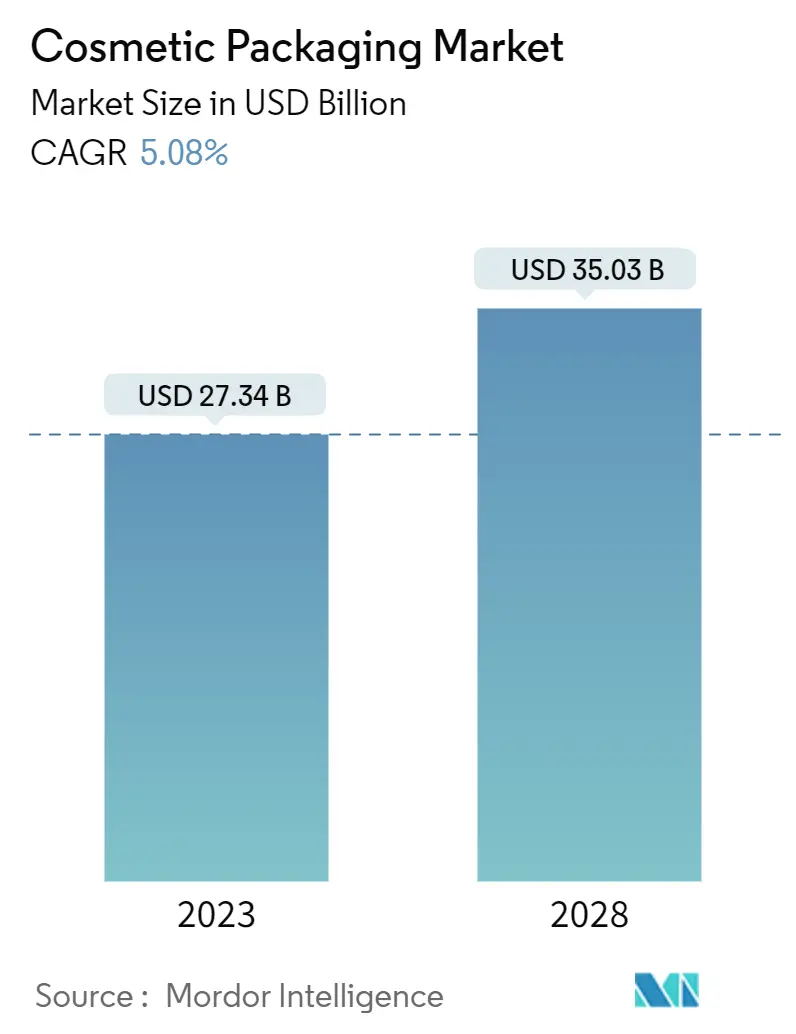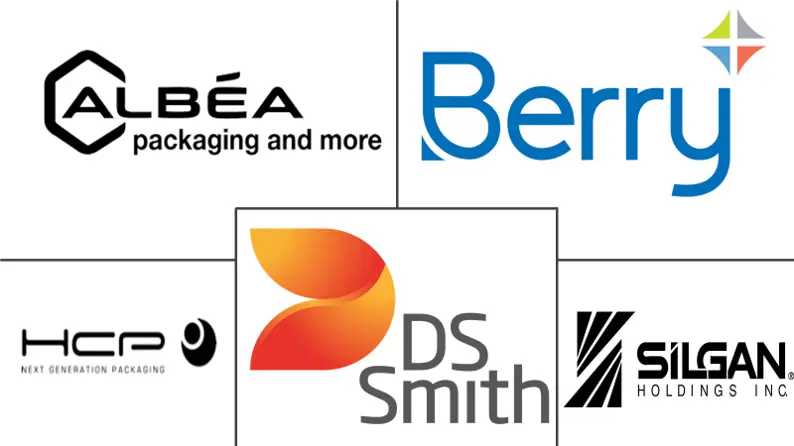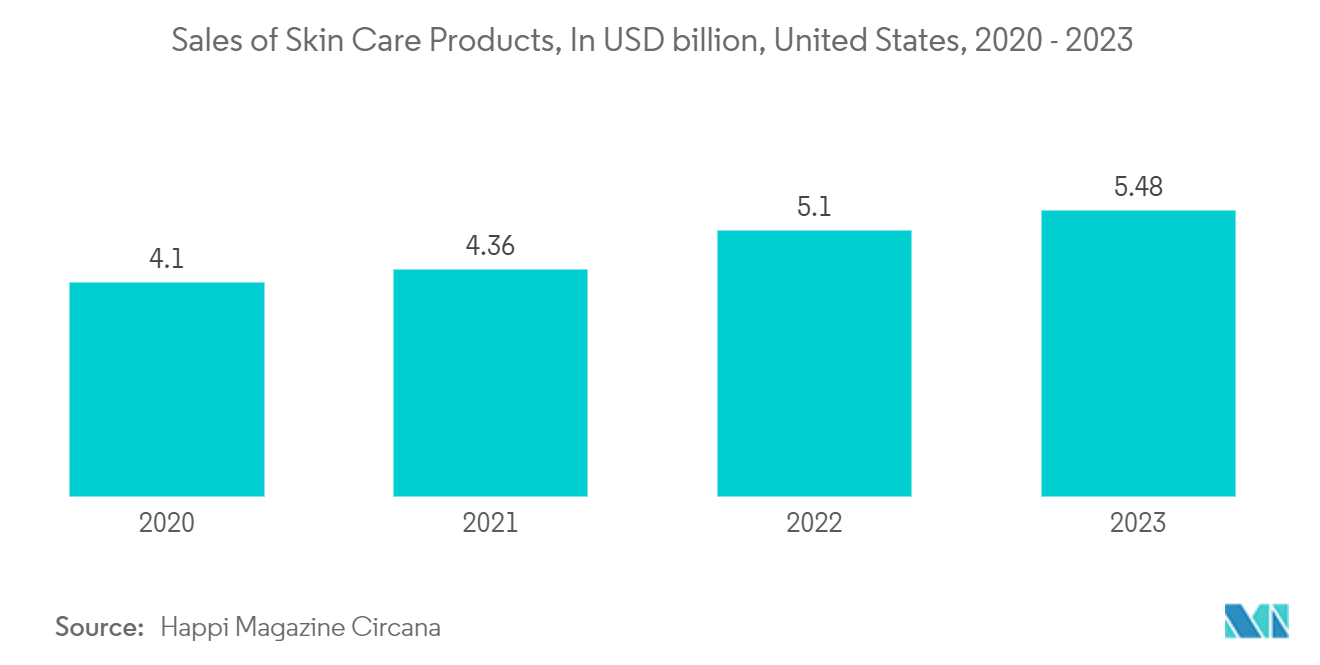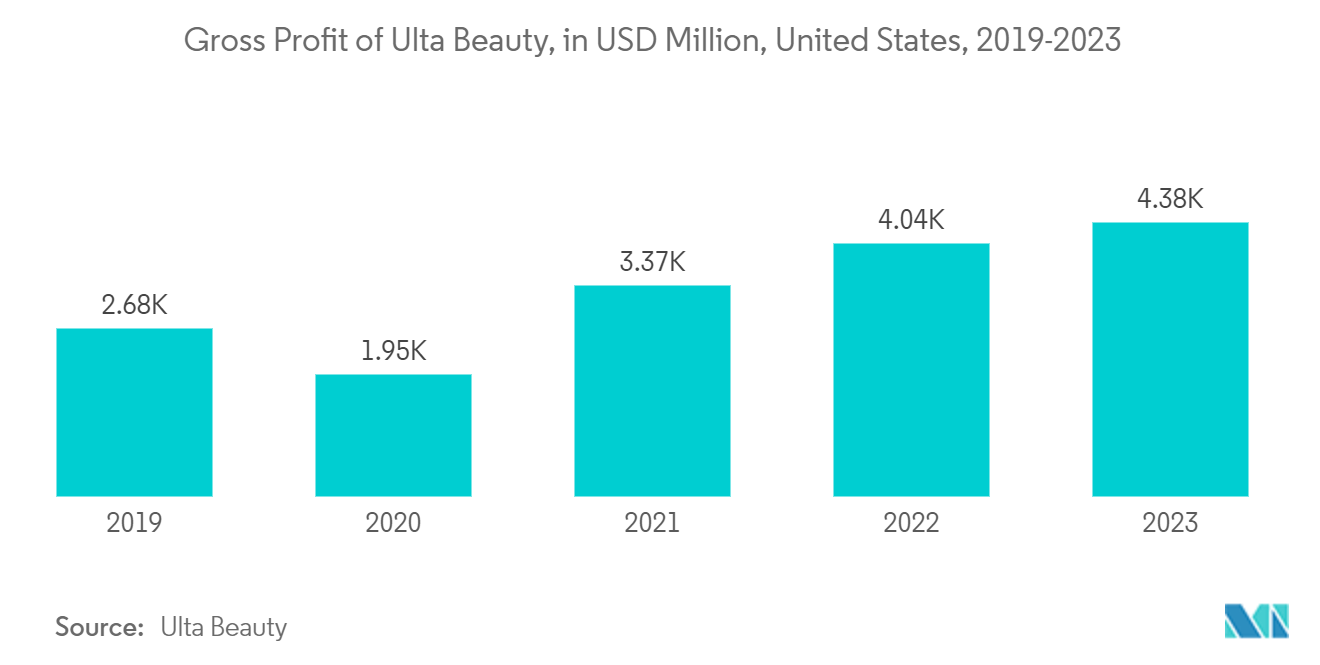Cosmetic Packaging Market Size

| Study Period | 2019 - 2029 |
| Market Size (2024) | USD 28.73 Billion |
| Market Size (2029) | USD 36.81 Billion |
| CAGR (2024 - 2029) | 5.08 % |
| Fastest Growing Market | North America |
| Largest Market | Asia |
Major Players
*Disclaimer: Major Players sorted in no particular order |
Need a report that reflects how COVID-19 has impacted this market and its growth?
Cosmetic Packaging Market Analysis
The Cosmetic Packaging Market size is estimated at USD 27.34 billion in 2023, and is expected to reach USD 35.03 billion by 2028, growing at a CAGR of 5.08% during the forecast period (2023-2028).
Packaging in the cosmetic industry has witnessed robust growth in recent years. The cosmetic industry has a varied packaging requirement compared to other sectors.
- The materials used include glass, paper, and plastic. These materials are used to make cosmetic packaging products, such as containers and bottles, in various shapes and sizes and dispensing mechanisms.
- Packaging materials, such as plastic, can be used as primary and secondary packaging solutions, including flexible pouches, caps, closures, and nozzles, the industry's primary packaging materials. Plastic tubes are one of the significant containers in the cosmetic industry as they can store liquid-solid and semisolid materials and dispense products in controlled proportions. Also, compared to other container tubes, it can provide better contamination protection.
- The cosmetic industry has varied packaging requirements for all the other sectors. The cosmetics industry seems united to decrease the impact of plastic pollution with new packaging strategies and refined formulations. Glass is one of the oldest packaging materials, which is nonporous and impermeable. It does not degrade, providing chemically inert properties. Glass adds to the premium appeal of the products and allows buyers to see the content and its color, thus giving them an idea of what they are getting. This is one of the main reasons why glass is used in cosmetic packaging.
- The rising consumer spending on grooming and beauty products drives the demand for premium products, augmenting the demand for glass bottles and containers for such product packaging and influencing market growth. Additionally, emerging economies are expected to create a favorable demand for cosmetic products and their packaging. As a result, economies like India and Southeast Asian countries are proving to be lucrative markets for cosmetics packaged in attractive glass packaging.
- Companies operating in the industry are focused on innovating new products as part of their business expansion. In October 2023, SGD Pharma unveiled its latest glass packaging innovations at the upcoming Luxe Pack Monaco event. These innovations include fragrance mini samplers and the Eclipse refillable glass jar. In addition, SGD Pharma offers the Constellations range of glass packaging solutions, which come in various shapes and are suitable for skin care and nutraceutical applications.
- Setting up the manufacturing unit for cosmetic packaging is capital-intensive and involves using large furnaces and machines. Cosmetics require an appealing package design that attracts clients and is appealing on-shelf displays. Thus, brands operating within this segment are developing attractive glass packaging solutions to gain customer focus and enhance their business, which adds to design costs.
Cosmetic Packaging Market Trends
Skincare is Expected to Hold Significant Share
- The demand for skincare products, especially among millennials, is on the rise, driven by various factors such as the desire to delay the signs of aging, increasing awareness of skincare routines, and the influence of social media. This growing demand directly impacts the demand for such products in the market, aiding skincare packaging manufacturing.
- The younger population focusing on skincare has led to an increased emphasis on developing specialized formulations that cater to their specific needs and preferences. This includes products that incorporate organic and natural ingredients, as millennials prioritize sustainability and clean beauty. Consequently, packaging manufacturers in the skincare industry are investing more in research and development to meet these demands.
- In addition to health-related concerns, buyers have a growing general environmental awareness. While selecting organic products, people are gravitating toward sustainable glass packaging options over any other material.
- In February 2023, Kinder Beauty launched an organic skincare range and introduced three serums in the market. These products, including other chemical-sensitive essential oils, lotions, and creams, must be stored in glass to keep the products fresh and healthy. It does not require any treatment or liners to remain inert. The rising trend of organic skincare products is also expected to fuel demand for glass bottles for safety reasons.
- Innovative packaging solutions, such as airless pumps and dropper bottles, help preserve products' potency and shelf life while enhancing hygiene. Interactive packaging, like QR codes, allows for virtual product testing and personalized recommendations. There is also a growing focus on sustainability, with options for recyclable plastic or packaging made from sustainable materials like bamboo or biodegradable substances.
- Skincare spending in all age groups has increased in the recent past. For instance, sales of skincare products in the United States in 2023 were recorded at USD 5.48 billion, which increased from USD 4.1 billion in 2020. The demand for skincare products impacts the market for different formats of cosmetic packaging.

North America is Expected to Record Significant Share
- The United States is a prominent player in the cosmetic packaging market. The industry comprises major stakeholders crafting different packaging products tailored to cosmetic needs. With the growing urbanization, increasing disposable income, and women’s employment throughout the region, the players operating in the market are expanding their production capacities for cosmetic packaging products.
- The regulatory requirements outlined by the Cosmetic Regulations in Canada, emphasizing the need for cosmetics to be manufactured and stored under sanitary conditions, play a crucial role in shaping the country’s cosmetic packaging. Adherence to sanitary conditions mandated by regulations ensures that the manufacturing and storage processes meet specific quality and safety standards.
- As consumers increasingly lean toward premium functional products, there is a parallel demand for packaging that complements the premium nature of these items. Various packaging materials, including glass bottles and containers, plastic tubes, and aerosol cans, with their premium and sophisticated appeal, align well with the image of natural cosmetics. Brands may opt for different packaging materials as per their requirement to convey a sense of luxury and quality, enhancing the overall perceived value of their products.
- High sales figures in specific cosmetic segments may also encourage innovation in packaging design. Companies invest in creating aesthetically pleasing and functional packaging designs that align with the latest trends and consumer preferences, increasing profit margins. For instance, in 2023, Ulta Beauty in the United States witnessed a gross profit of USD 4,381.1 million, which increased from USD 4,044.51 million in 2022.
- Moreover, the growing awareness of environmental concerns among consumers has led to a preference for sustainable packaging options. Glass is a recyclable and eco-friendly material that aligns with the increasing demand for sustainable practices. The higher expenditure on cosmetics and perfumery products may drive a shift toward environmentally friendly packaging solutions, benefiting the market for glass bottles.

Cosmetic Packaging Industry Overview
The cosmetic packaging market is fragmented and comprises several global and regional players. Innovation and ease in deployment and usage, leading to end-to-end customer satisfaction through the product, have been the key factors driving product innovation and strategies among the market players. The key players in the market include Silgan Holdings Inc., Albea SA, Silgan Holdings Inc., HCP Packaging Co. Ltd, and DS Smith PLC.
- In February 2024, Aptar Group Inc. introduced its Future Disc Top, a fully recyclable closure, to withstand the rough e-commerce journey and provide brands and consumers peace of mind. Ideal for the beauty and personal care categories, Future Disc Top stands out on several fronts and is made completely from polyethylene (PE), a commonly recycled packaging material.
- In January 2024, Quadpack partnered with Collister to develop the new LIFT HD+ Smoothing Lifting Concealer, a beauty product meant to erase fatigue indications and bring back brightness. The product, which has 95% natural components, is packaged in a monomaterial solution from Quadpack that improves user experience. The Essential applicator is paired with the visually appealing thick-walled bottle of the Gala dip-in pack to create a remarkably smooth and effortless application. The pack satisfies the brand's requirement for the exclusive use of recyclable materials because it is composed completely of polyethylene terephthalate (PET).
Cosmetic Packaging Market Leaders
Albea S.A.
DS Smith PLC
Silgan Holdings Inc
Berry Global Inc.
HCP Packaging Co. Ltd.
*Disclaimer: Major Players sorted in no particular order
.webp)
Cosmetic Packaging Market News
- March 2024 - GEKA, the beauty brand of Medmix, is innovating the cosmetics packaging industry with a revolutionary material innovation in sustainable cosmetics. Developed in close cooperation with GEKA's long-term partner WIS-Kunststoffe, the new material is made from at least 95% recycled PP plastic and is odorless. It has been tested against several stringent international standards for cosmetic and food production industries.
- February 2024 - APC Packaging announced the launch of its eco-friendly all-plastic airless pump, EAPP EcoReady. This pump is made from plastic and is designed with airless technology for a more sustainable dispensing solution for the beauty and cosmetic market.
Cosmetic Packaging Market Report - Table of Contents
1. INTRODUCTION
1.1 Study Assumptions and Market Definition
1.2 Scope of the Study
2. RESEARCH METHODOLOGY
3. EXECUTIVE SUMMARY
4. MARKET DYNAMICS
4.1 Market Overview
4.2 Market Drivers
4.2.1 Increasing Consumption of Cosmetic Products
4.2.2 Increasing Focus on Innovation and Attractive Packaging
4.3 Market Restraints
4.3.1 Growing Sustainability Concerns
4.4 Industry Value Chain Analysis
4.5 Industry Attractiveness Porter's Five Forces Analysis
4.5.1 Bargaining Power of Suppliers
4.5.2 Bargaining Power of Buyers
4.5.3 Threat of New Entrants
4.5.4 Threat of Substitute Products
4.5.5 Intensity of Competitive Rivalry
5. IMPACT OF COVID-19 ON THE INDUSTRY
6. MARKET SEGMENTATION
6.1 By Material Type
6.1.1 Plastic
6.1.2 Glass
6.1.3 Metal
6.1.4 Paper
6.2 By Product Type
6.2.1 Plastic Bottles and Containers
6.2.2 Glass Bottles and Containers
6.2.3 Metal Containers
6.2.4 Folding Cartons
6.2.5 Corrugated Boxes
6.2.6 Tubes and Sticks
6.2.7 Caps and Closures
6.2.8 Pump and Dispenser
6.2.9 Droppers
6.2.10 Ampoules
6.2.11 Flexible Plastic Packaging
6.3 By Cosmetic Type
6.3.1 Hair Care
6.3.2 Color Cosmetics
6.3.3 Skin Care
6.3.4 Men's Grooming
6.3.5 Deodorants
6.3.6 Other Cosmetic Types
6.4 By Geography***
6.4.1 North America
6.4.1.1 United States
6.4.1.2 Canada
6.4.2 Europe
6.4.2.1 United Kingdom
6.4.2.2 Germany
6.4.2.3 France
6.4.2.4 Italy
6.4.2.5 Spain
6.4.3 Asia-Pacific
6.4.3.1 China
6.4.3.2 India
6.4.3.3 Japan
6.4.3.4 South Korea
6.4.3.5 Austrlia and New Zealand
6.4.4 Latin America
6.4.4.1 Brazil
6.4.4.2 Mexico
6.4.4.3 Argentina
6.4.5 Middle East and Africa
6.4.5.1 United Arab Emirates
6.4.5.2 Saudi Arabia
6.4.5.3 South Africa
7. COMPETITIVE LANDSCAPE
7.1 Company Profiles*
7.1.1 Albea SA
7.1.2 HCP Packaging Co. Ltd
7.1.3 RPC Group PLC (Berry Global Group)
7.1.4 Silgan Holdings Inc.
7.1.5 DS Smith PLC
7.1.6 Graham Packaging LP
7.1.7 Libo Cosmetics Company Ltd
7.1.8 AptarGroup Inc.
7.1.9 Amcor Group GmbH
7.1.10 Cosmopak Ltd
7.1.11 Quadpack Industries SA
7.1.12 Rieke Corporation
7.1.13 Gerresheimer AG
7.1.14 Raepak Ltd
7.1.15 Ball Corporation
7.1.16 Verescence France
7.1.17 SKS Bottle & Packaging Inc.
7.1.18 Altium Packaging (Loews Corporation)
8. INVESTMENT ANALYSIS
9. FUTURE OUTLOOK OF THE MARKET
Cosmetic Packaging Industry Segmentation
A cosmetic substance is anything used to clean, enhance, or change the appearance of the face, body, hair, fingernails, or teeth. Cosmetic products include make-up, perfumes, skin creams, nail polish, and grooming products such as soap, shampoo, shaving creams, and deodorants. The study tracked the need for different types of packaging used to pack cosmetic products to keep the products away from spoiling, moisture, UV, and more.
The cosmetic packaging market is segmented by material (plastic, glass, metal, and paper), product type (plastic bottles and containers, glass bottles and containers, metal containers, folding cartons, corrugated boxes, tubes and sticks, caps, and closures, pump and dispenser, droppers, ampoules, and flexible plastic packaging), cosmetic type (hair care, color cosmetics, skincare, men grooming, and deodorants), and geography (North America [United States and Canada], Europe [United Kingdom, Germany, France, Italy, Spain, and Rest of Europe], Asia [China, India, Japan, South Korea, Thailand, Rest of Asia-Pacific, and Australia], Latin America [Brazil, Mexico, Argentina, and Rest of Latin America], and Middle East and Africa [United Arab Emirates, Saudi Arabia, Rest of Middle East and Africa, and South Africa]). The market sizes and forecasts are in terms of revenue (USD) for all the above segments.
| By Material Type | |
| Plastic | |
| Glass | |
| Metal | |
| Paper |
| By Product Type | |
| Plastic Bottles and Containers | |
| Glass Bottles and Containers | |
| Metal Containers | |
| Folding Cartons | |
| Corrugated Boxes | |
| Tubes and Sticks | |
| Caps and Closures | |
| Pump and Dispenser | |
| Droppers | |
| Ampoules | |
| Flexible Plastic Packaging |
| By Cosmetic Type | |
| Hair Care | |
| Color Cosmetics | |
| Skin Care | |
| Men's Grooming | |
| Deodorants | |
| Other Cosmetic Types |
| By Geography*** | |||||||
| |||||||
| |||||||
| |||||||
| |||||||
|
Cosmetic Packaging Market Research FAQs
How big is the Cosmetic Packaging Market?
The Cosmetic Packaging Market size is expected to reach USD 28.73 billion in 2024 and grow at a CAGR of 5.08% to reach USD 36.81 billion by 2029.
What is the current Cosmetic Packaging Market size?
In 2024, the Cosmetic Packaging Market size is expected to reach USD 28.73 billion.
Who are the key players in Cosmetic Packaging Market?
Albea S.A., DS Smith PLC, Silgan Holdings Inc, Berry Global Inc. and HCP Packaging Co. Ltd. are the major companies operating in the Cosmetic Packaging Market.
Which is the fastest growing region in Cosmetic Packaging Market?
North America is estimated to grow at the highest CAGR over the forecast period (2024-2029).
Which region has the biggest share in Cosmetic Packaging Market?
In 2024, the Asia accounts for the largest market share in Cosmetic Packaging Market.
What years does this Cosmetic Packaging Market cover, and what was the market size in 2023?
In 2023, the Cosmetic Packaging Market size was estimated at USD 27.27 billion. The report covers the Cosmetic Packaging Market historical market size for years: 2019, 2020, 2021, 2022 and 2023. The report also forecasts the Cosmetic Packaging Market size for years: 2024, 2025, 2026, 2027, 2028 and 2029.
What is the fastest-growing packaging material in Cosmetic Packaging Market?
Plastic is the fastest growing packaging material due to its affordability, versatility, and lightweight properties, despite sustainability concerns.
Cosmetic Packaging Industry Report
The global cosmetic packaging market is on a significant upswing, propelled by the escalating demand for cosmetic products alongside a surge for innovative, attractive, and eco-friendly packaging solutions. With plastic as a traditionally dominant material, there's a noticeable pivot towards sustainable alternatives like glass, metal, and paper-based options, driven by consumer preferences and regulatory mandates for environmental stewardship. The bottles segment, known for its durability, leads the market, particularly for fragrances and premium items, while the skincare category emerges as the top application sector due to the worldwide demand for personal care products. The Asia Pacific region takes the lead due to its vast population, increasing disposable incomes, and digital advancements shaping consumer habits. North America and Europe are not far behind, with a keen focus on sustainable packaging and premium cosmetic offerings. Despite challenges like environmental concerns and volatile raw material costs, the market is evolving with cutting-edge packaging designs and materials, striving to align with consumer expectations and sustainability criteria. Statistics for the cosmetic packaging market share, size and revenue growth rate, created by Mordor Intelligence™ Industry Reports. Cosmetic packaging analysis includes a market forecast outlook and historical overview. Get a sample of this industry analysis as a free report PDF download.
